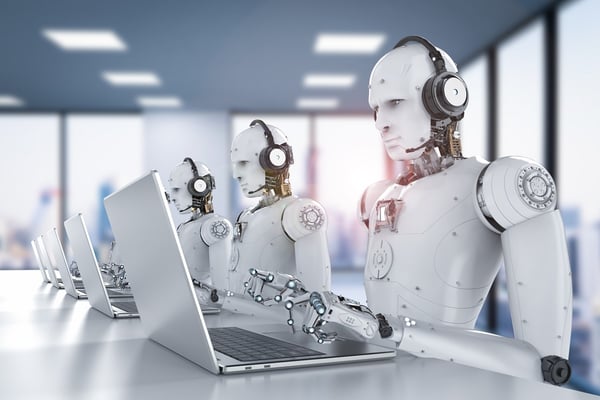Human-Robot Collaboration in the Workplace
We’ve all seen sci-fi movies where robots take over the world, that is until Will Smith (or similar) steps in at the eleventh hour and saves the day. But like a lot of movies made, they do have a good knack of portraying what the future might hold, whether that’ll be a home robot for doing the daily chores to an all singing all dancing fully autonomous home.

It was reported by the McKinsey Global Institute that over 800 million jobs will be replaced by robot automation by 2030 and that a third of the workforce in some of the more developed countries will be required to retrain in another trade or face losing their jobs. But fear not, we have been here a few times before. A switch from farming to factory work happened at the turn of the last century and then the age of computers created new jobs in technology which then went onto replacing the factory worker.
The number of people working in a factory, particularly in manufacturing has fallen sharply because of robotics, thus enabling machines to take on the repetitive heavy labour tasks. It has been proven that 90% of roles within a factory could be automated, a move which has resulted in fewer defects and an increase in production – think car building and the reliability of the current motor car.
Robots can now carry out the majority of tasks on their own (once programmed), meaning only a few human staff members are required to keep an eye on them and carry out routine maintenance. Robots can work 24/7 and don’t have to break for the toilet!
If you look around, robots and automation are everywhere, you’ll see self-service tills in just about every supermarket, train ticket machines dispensing pre-ordered tickets, self-parking and driving cars along with all the things you can control via your smart phone like lighting and heating.
Our jobs are being displaced, jobs that are repetitive or considered dull will surely be top of the list to be replaced, data entry (transferring data from one source to another), factory work (picking and packing), drivers (taxi’s and freight), financial analysts (measuring the degree of risks) and customer services (chatbots). Other roles like those in the medical profession where computers are used to diagnose and to recommend best treatment based upon results of tests etc. Also, some surgical procedures can be carried out by robots.
It’s fair to say that most, if not all, robots can do a consistently better job than we can. Artificial Intelligence (AI) can outperform us at repetitive, programmable tasks, operating faster and more efficiently than we humans can. But it’s not all bad, luckily machines aren't great at being humans, imagination, ingenuity and intricate problem-solving will still stay firmly with us for now. Businesses will see that continued success isn't about reducing the workforce by replacing workers with automated systems. Instead, it's all about using machines in such a way to allow humans to do a better job than we've ever been able to do before.
Let’s relax for a moment, we know that the human has evolved over millions of years, it’s not been a quick or easy process, our hands for example are unique from our finger prints, the way we grip and the use of our thumbs are yet to be perfected by robots, so we have (and excuse the pun) the ‘upper hand’ over our robotic friends. They may make our lives easier, but the total replacement of all jobs is a long way from now.
So, we should look optimistically ahead at the new challenges that robotics will bring. Testing will feature as ever, of course. We can automate some, if not all the testing, and as advancement in technology grows the more automation and opportunities we will have to follow a comprehensive set of guidelines that will produce beneficial business results. Creating an automation framework that will be followed time and time again will bring predictable results, these guidelines may include the common test tool used, coding standards and expected outcomes.
Those of you already working in the testing arena will know that Test Automation frameworks are an essential part of any successful automated testing process. Not only can they reduce maintenance costs and testing effort but will provide a greater return on investment for testing teams whether they are working in Agile or Waterfall projects.
So the question is, will robots bring the end of the world? Well, robots are a reality today and as they will begin to appear in public spaces in different forms, robots will not be human-like, they might look like us, but they will remain just sophisticated machines. So, you can stand down from any fear of a robot uprising in the near future.








.png)
